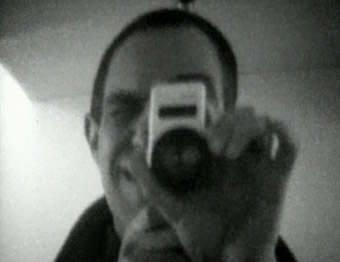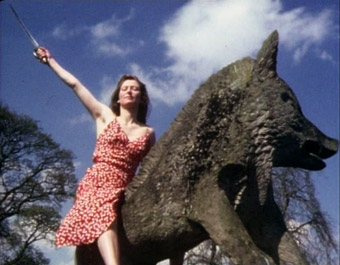|
If
you're a follower of the cinema of Derek Jarman then you'll
know all about Blue and probably have experienced
it. Others will know it by reputation and may even have
formed an opinion from what they've heard or read, one that could
just have have seen it crossed off their list of films to see before
they die. For the rest of you, here's a one-sentence summary: to an unchanging
plain blue screen, a complex soundtrack unfolds in which
music and sound effects are blended with the director's
experiences of his medical treatment and failing health following his contraction of AIDS,
which is related in a varying mixture of the poetic and the observational.
Now
when I say unchanging blue screen I mean it – following
the opening credits, the screen turns blue and stays that
way until the end of the film. If there were an award for being true
to your title, Blue would win it hands
down. The criticisms that have been aimed at the film are
both predictable and valid. The most commonly heard is that
film devoid of specific visuals belongs on the radio rather
than in the cinema, and the only reason it was released as a film at all is that a radio play would neither attract
as big an audience nor receive the same publicity,
especially if the word 'controversial' was in any way attached
to it. It's even been suggested that you could issue
it as a CD with a fold-out blue sheet for the listener to
stare at as they played it. And if the
blue screen is designed to fully focus our attention on
the soundtrack, would not simply closing your eyes do
the same thing?

But
the use of a blue screen is anything but arbitrary. A key
symptom of Jarman's degenerating health, and the one that
had the most significant effect on him as an artist, was
the gradual loss of his sight, and the final image he was able
to register was the colour blue. In terms of placing
you within the director's experience, this proves an effective
device, removing any generic associations, whether they
be dramatic or documentary, and forcing the viewer to experience
a sightless world, stripping a traditionally audio-visual
experience of one of its key components. Of
course this plays very differently on a cinema screen than
it does on DVD. In the cinema, at least if you're sitting
close enough to the screen, the blue fills your field of
vision and radiates from the screen to colour everything around you. Unless
you're hooked up to a projector, the DVD just isn't
going to dominate your vision in the same way, and it would
be an unusually determined viewer who was able to stare
unwaveringly at the luminous blue of their TV screen for
74 minutes without a break.
This
is not necessarily a problem. My second viewing of the film
and the first on DVD took place late at night when I was
in the throes of a streaming cold and looking at the screen
for any length of time would kick off a sneezing fit. Eventually
I laid back, closed my eyes and just absorbed the soundtrack,
the blue that was bathing the darkened room still just detectable
through my eyelids. It may not be true to the film's intentions – then again I'd already experienced that in the cinema
on the film's release – but I still became involved and
moved by what I heard and still marvelled at the writing, performance
and poetic truth of the piece. The soundtrack is remarkable
in every respect, a compellingly performed and designed
blend of poetry, experience, observation, sound effects
and music (by Jarman regular Simon Fisher-Turner) that locks
the viewer/listener into the director's experience and thoughts
as the symptoms take hold and his relationship with the
world around him is changed forever.
It's
tricky to recommend Blue unreservedly because
for many it will always be a soundtrack in search of a picture,
a view that I'd suggest is partly the result of a self-imposed
barrier born of a specific idea of the form cinema should
take. But for the open minded and those prepared to put
that barrier aside, Blue is a unique and
affecting experience. And you know what, there are mega-budget
Hollywood films out there on which millions upon millions
of dollars have been lavished whose visuals are ultimately
less meaningful than Jarman's simple blue screen.
Those
who found it easy to take pot shots at Blue
should have a field day with Jarman's final film, Glitterbug,
which consists of nothing more than a montage of the director's
home movie footage set to music. There, I bet a few of you
have already used that essentially accurate but nonetheless
glib description to form an opinion on the film, or at least
the foundations of one.

Compiled
from twenty years of Super-8 footage shot by Jarman, the
film mixes monochrome with colour, the personal with the
professional and the observational with the experimental.
Thus shots of a lover shaving or eating breakfast sit happily
alongside time-lapse footage of a day's activity in Jarman's
studio flat, lighter moments on the shoots of Sebastiane
and Jubilee, a playful jaunt around a country
garden, a group of female impersonators preparing for a
fashion show, glimpses of The Sex Pistols and William Burroughs,
and lingering shots of the bodies and faces of well-toned
young men. And that's just a sample. In rare moments Jarman
himself appears before the lens, receiving a new movie camera
as a present or having his hair cut to the crop that partly
defined his late career look. Continuity is provided to
the disparate imagery by Brian Eno's hypnotic, hallucinatory
score, which shifts in tone and mood to perfectly compliment
and sometimes counterpoint the visuals.
No
movie exists in a vacuum and each is inevitably tied to
external factors that influence and shape their appreciation
and even understanding. Divorced from its associations with
the director's life and death, Glitterbug
would be an involving though hardly groundbreaking experiment,
but as cinematic memorial, a final before-the-eyes flash
of a life less ordinary, it is captivating, rich with detail
and profoundly moving.
OK,
this is a tricky one to write about without sounding as
if I'm taking the piss a bit, which I'm not. Blue has received an anamorphic 1.85:1 transfer, designed to
fill a widescreen TV's viewing area, but you'll need to
make some adjustments to your DVD player to get the full
screen experience on a 4:3 set. Artificial Eye have transferred
the original print rather than create a digital blue of
the same hue to replace it – this is true to the original
film, as you would expect of this distributor, but the print
is not in absolutely pristine condition and the unbroken
blue is thus given occasional movement in the shape of dust
spots, particularly at the start. An argument could be made
for digital restoration here.
Glitterbug is framed 4:3 and inevitably grainy,
with some of the original footage alive with dust, dirt
and scratches, but the transfer is nonetheless impressive,
with the contrast and detail on the monochrome footage a
lot better than the 8mm source might lead you to expect,
and there's a pleasing richness to some of the colour shots. There
a particular quality to 8mm film that is well captured here
that will doubtless leave many modern videographers mourning
the format's passing.

Both
films have Dolby stereo 2.0 soundtracks and both are very
clear and well mixed and display distinct separation, particularly
Blue's use of location sound and effects.
Brief
Biographies for Derek Jarman,
Tilda Swinton, Nigel Terry, John Quentin, Simon Fisher-Turner,
James Mackay and Brian Eno.
Challenging
though the concept may be, Blue is nonetheless
an important and affecting work that deserves more than
sidelining as an avant-garde experiment, while Glitterbug is an illuminating and moving swan song from one of this
country's most distinctive filmmaking talents. Jarman's
final two films differ in style and approach but still compliment
each other perfectly, and Artificial Eye have done well
pairing them together for this release. Recommended, at least for the adventurous.
|